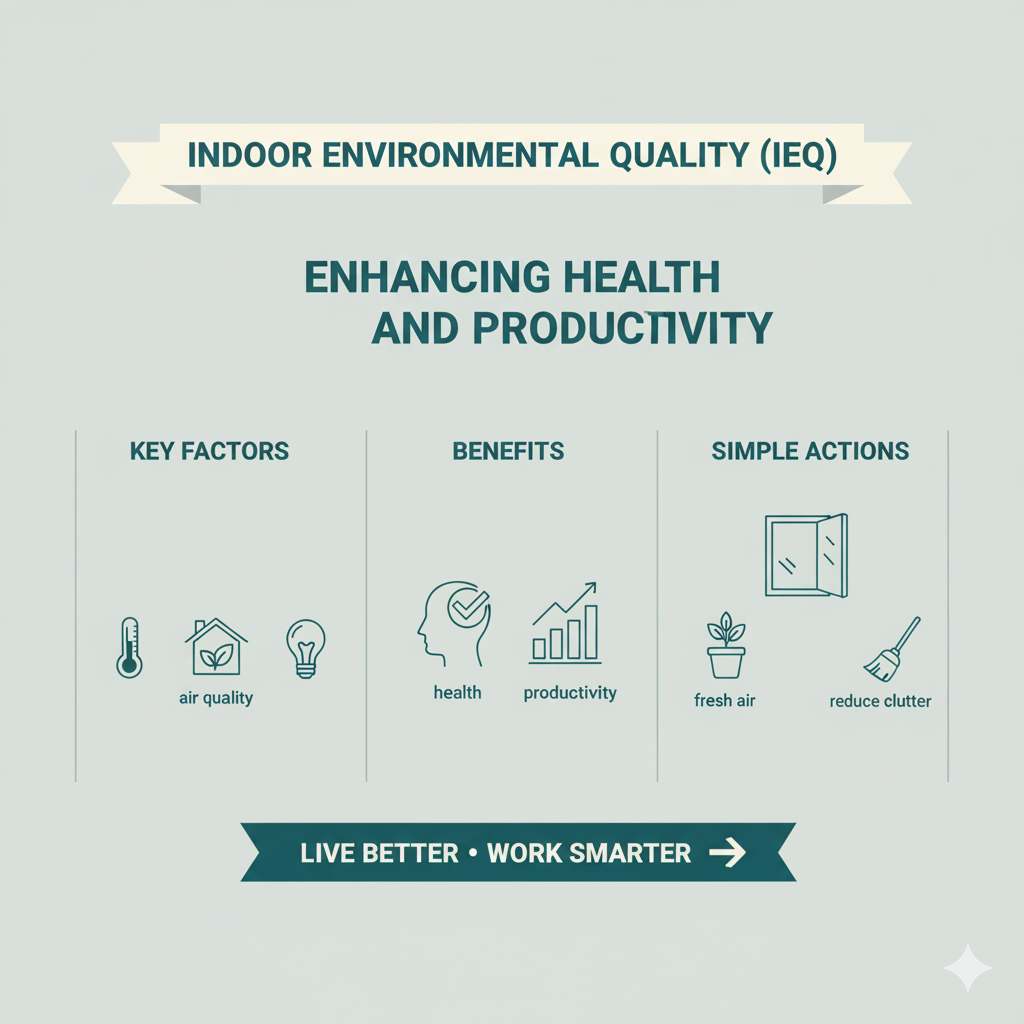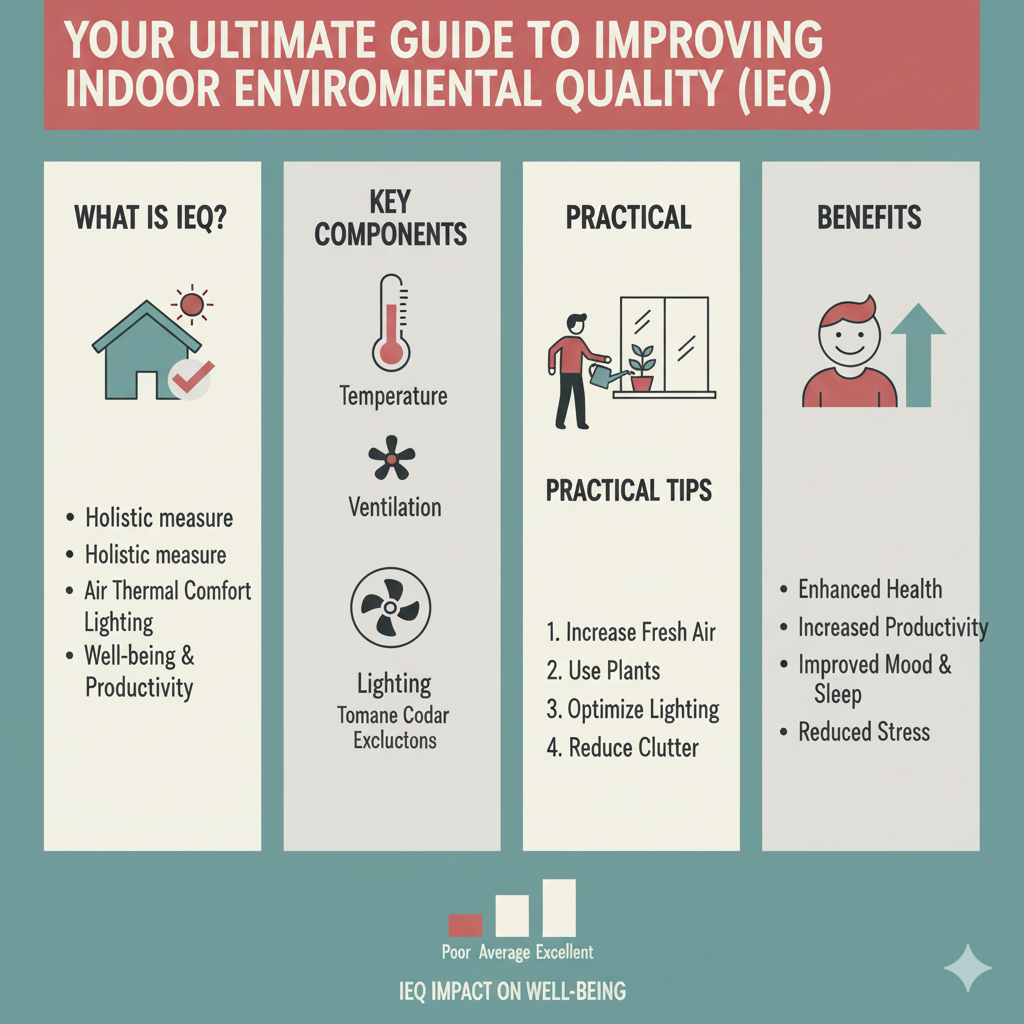Indoor Environmental Quality (IEQ): Enhancing Health and Productivity

Introduction
Indoor Environmental Quality (IEQ) refers to the conditions within a building that affect the health, comfort, and productivity of its occupants. The quality of the indoor environment plays a crucial role in enhancing the well-being of individuals in residential, commercial, and institutional settings. As people spend up to 90% of their time indoors, the need to ensure high IEQ is more critical than ever.
In this essay, we will explore the significance of Indoor Environmental Quality, the key factors that contribute to it, and practical measures to improve it. We’ll also discuss the health benefits, the relationship between IEQ and productivity, and offer actionable tips for homeowners, building managers, and designers.
What is Indoor Environmental Quality (IEQ)?
Indoor Environmental Quality (IEQ) encompasses various factors that impact the overall comfort, health, and performance of individuals in indoor spaces. It includes the following elements:
-
Air Quality: The presence of pollutants, ventilation, and humidity levels.
-
Lighting: Natural and artificial light sources.
-
Acoustic Quality: Noise levels and sound insulation.
-
Thermal Comfort: The temperature and humidity balance.
-
Ergonomics: The design and layout of furniture and workspaces.
Improving IEQ involves controlling and optimizing these variables to create healthier and more comfortable environments. This focus on IEQ has become even more significant in today’s world of energy-efficient buildings, where air circulation and natural light may be limited to conserve energy.
Importance of Indoor Environmental Quality (IEQ)
The importance of IEQ is evident in its direct impact on human health and productivity. Poor indoor environments can lead to various health issues and a reduction in overall well-being, while optimal IEQ can:
1. Promote Health and Wellness
-
Reduced Respiratory Issues: Good air quality helps prevent asthma, allergies, and respiratory infections.
-
Improved Mental Health: Proper lighting, ventilation, and comfortable temperatures can reduce stress and fatigue.
-
Reduced Sick Building Syndrome (SBS): SBS is a phenomenon where people working in a specific building experience symptoms like headaches, dizziness, or throat irritation due to poor indoor conditions.
2. Boost Productivity
-
Enhanced Concentration: Good lighting and optimal acoustics can reduce distractions and improve focus.
-
Energy Levels: A comfortable indoor environment can increase energy and motivation among employees or students.
-
Creativity: A well-lit and aesthetically pleasing environment enhances creativity and innovation in workplaces.
🔗 IEQ’s Impact on Office Productivity
3. Increase Comfort
-
Proper thermal comfort (neither too hot nor too cold) is essential for a relaxed atmosphere.
-
Low noise levels make spaces more comfortable to live and work in.
Key Factors Affecting Indoor Environmental Quality
1. Indoor Air Quality (IAQ)
Indoor air quality is perhaps the most critical factor in overall IEQ. Poor IAQ can lead to a range of health issues, including headaches, dizziness, eye irritation, and respiratory problems.
Key IAQ Elements:
-
Ventilation: Proper ventilation is necessary to maintain air freshness by removing indoor pollutants.
-
Pollutants: Common indoor pollutants include volatile organic compounds (VOCs) from paints and cleaning products, carbon dioxide (CO2), and particulate matter (PM).
-
Humidity: High humidity levels can encourage the growth of mold and dust mites, while low humidity can cause dry skin and respiratory discomfort.
Solutions:
-
Regularly replacing HVAC filters.
-
Ensuring proper ventilation systems that meet local codes.
-
Using air purifiers to reduce airborne particles.
🔗 Air Quality Standards and Tips
2. Lighting
Lighting affects more than just visibility—it impacts mood, sleep patterns, and productivity. Both natural and artificial lighting are essential in creating a comfortable environment.
Types of Lighting:
-
Natural Lighting: Sunlight provides health benefits by regulating circadian rhythms and improving mood.
-
Artificial Lighting: Energy-efficient LED lights are a great option for both residential and commercial buildings. Adjustable lighting can also improve comfort.
Solutions:
-
Maximize natural light by using large windows or light shelves.
-
Use LED lighting with dimmable options to reduce glare.
-
Position lighting to reduce shadows, particularly in workspaces.
🔗 Energy-Efficient Lighting Solutions
3. Acoustic Quality
Noise is an often-overlooked aspect of indoor environments. Excessive noise can increase stress, hinder concentration, and negatively impact sleep quality.
Key Considerations:
-
Noise from HVAC systems: Mechanical systems can create disruptive sounds.
-
External noise: Traffic or construction noise can infiltrate buildings.
-
Internal noise: People’s conversations and machinery can create distractions.
Solutions:
-
Install soundproofing materials, such as acoustic panels or carpets.
-
Use white noise machines or sound masking to cover disruptive noises.
-
Consider layout adjustments that create quieter spaces.
🔗 Acoustic Solutions for Better IEQ
4. Thermal Comfort
Thermal comfort refers to maintaining a comfortable indoor temperature and humidity level. When the temperature or humidity is not regulated, it can lead to discomfort and reduced focus or productivity.
Key Considerations:
-
Temperature: The ideal indoor temperature is typically between 68°F (20°C) and 72°F (22°C).
-
Humidity: The ideal indoor humidity range is between 30% and 60%.
-
Airflow: Proper airflow prevents stuffiness and maintains an even temperature throughout a room.
Solutions:
-
Utilize programmable thermostats for precise temperature control.
-
Ensure effective HVAC systems and ventilation.
-
Use dehumidifiers or humidifiers to maintain the ideal humidity levels.
5. Ergonomics and Layout
Ergonomics focuses on optimizing indoor space design to improve comfort and prevent strain or injury. An ergonomic workspace reduces fatigue and enhances productivity.
Key Elements:
-
Furniture Design: Ergonomic furniture ensures that workers or residents are seated comfortably with minimal strain.
-
Workstations: Properly adjusted desks and chairs can promote good posture and reduce back and neck pain.
-
Room Layout: A functional room layout ensures easy movement and access to resources without causing stress or discomfort.
Solutions:
-
Invest in ergonomic chairs and desks.
-
Position monitors at eye level to prevent neck strain.
-
Create an open layout that encourages natural flow and easy movement.
Improving Indoor Environmental Quality: Practical Tips
Now that we’ve explored the critical factors that contribute to Indoor Environmental Quality (IEQ), here are actionable tips that individuals and organizations can implement to improve their indoor environments.
For Homeowners:
-
Install high-quality air purifiers to remove allergens and pollutants.
-
Use energy-efficient lighting such as LED bulbs and maximize natural light.
-
Set up humidifiers or dehumidifiers to maintain optimal humidity levels.
-
Opt for ergonomic furniture to improve comfort in your home office.
For Commercial Spaces:
-
Conduct regular IAQ assessments to monitor and improve air quality.
-
Use acoustic treatments to reduce noise pollution.
-
Create zones with temperature control to ensure comfort for all employees.
-
Invest in smart lighting systems that adjust based on natural light and occupancy.
For Builders and Architects:
-
Use sustainable building materials that minimize off-gassing of toxic substances.
-
Incorporate green roofs or living walls to enhance air quality and provide natural insulation.
-
Design spaces with natural ventilation and use low-VOC paints to ensure better air quality.
🔗 Building Green: Indoor Environmental Quality
Conclusion
Indoor Environmental Quality (IEQ) is a crucial factor in ensuring that indoor spaces are conducive to health, comfort, and productivity. As we spend a significant portion of our lives indoors, it is essential to prioritize the quality of the air, lighting, acoustics, temperature, and ergonomics of our environments. By implementing the strategies and solutions discussed, we can significantly improve the indoor environments where we live, work, and learn.
Incorporating IEQ into building design and daily routines is not just beneficial—it’s necessary for creating healthier, more sustainable living spaces. By paying attention to the factors that affect IEQ, individuals, businesses, and architects can create spaces that promote well-being and enhance productivity, paving the way for a healthier and more productive future.
If you’d like to learn more about enhancing IEQ in your home or office, check out these resources:






